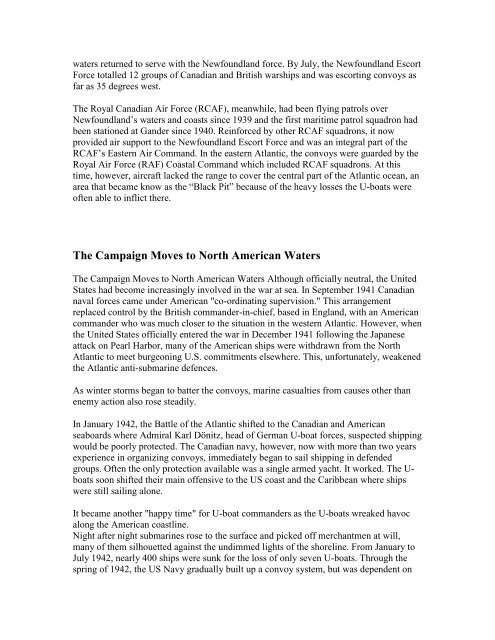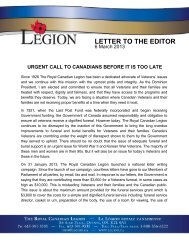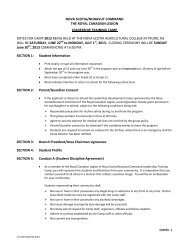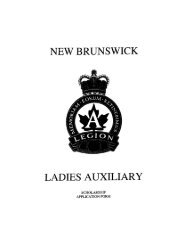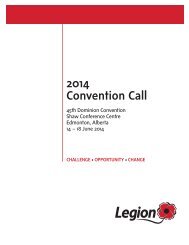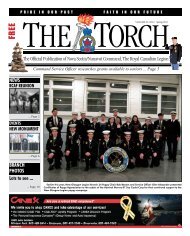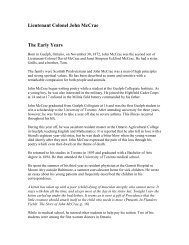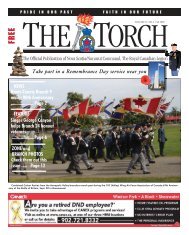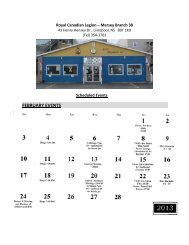Introduction The Battle of the Atlantic - Royal Canadian Legion
Introduction The Battle of the Atlantic - Royal Canadian Legion
Introduction The Battle of the Atlantic - Royal Canadian Legion
You also want an ePaper? Increase the reach of your titles
YUMPU automatically turns print PDFs into web optimized ePapers that Google loves.
waters returned to serve with <strong>the</strong> Newfoundland force. By July, <strong>the</strong> Newfoundland EscortForce totalled 12 groups <strong>of</strong> <strong>Canadian</strong> and British warships and was escorting convoys asfar as 35 degrees west.<strong>The</strong> <strong>Royal</strong> <strong>Canadian</strong> Air Force (RCAF), meanwhile, had been flying patrols overNewfoundland’s waters and coasts since 1939 and <strong>the</strong> first maritime patrol squadron hadbeen stationed at Gander since 1940. Reinforced by o<strong>the</strong>r RCAF squadrons, it nowprovided air support to <strong>the</strong> Newfoundland Escort Force and was an integral part <strong>of</strong> <strong>the</strong>RCAF’s Eastern Air Command. In <strong>the</strong> eastern <strong>Atlantic</strong>, <strong>the</strong> convoys were guarded by <strong>the</strong><strong>Royal</strong> Air Force (RAF) Coastal Command which included RCAF squadrons. At thistime, however, aircraft lacked <strong>the</strong> range to cover <strong>the</strong> central part <strong>of</strong> <strong>the</strong> <strong>Atlantic</strong> ocean, anarea that became know as <strong>the</strong> “Black Pit” because <strong>of</strong> <strong>the</strong> heavy losses <strong>the</strong> U-boats were<strong>of</strong>ten able to inflict <strong>the</strong>re.<strong>The</strong> Campaign Moves to North American Waters<strong>The</strong> Campaign Moves to North American Waters Although <strong>of</strong>ficially neutral, <strong>the</strong> UnitedStates had become increasingly involved in <strong>the</strong> war at sea. In September 1941 <strong>Canadian</strong>naval forces came under American "co-ordinating supervision." This arrangementreplaced control by <strong>the</strong> British commander-in-chief, based in England, with an Americancommander who was much closer to <strong>the</strong> situation in <strong>the</strong> western <strong>Atlantic</strong>. However, when<strong>the</strong> United States <strong>of</strong>ficially entered <strong>the</strong> war in December 1941 following <strong>the</strong> Japaneseattack on Pearl Harbor, many <strong>of</strong> <strong>the</strong> American ships were withdrawn from <strong>the</strong> North<strong>Atlantic</strong> to meet burgeoning U.S. commitments elsewhere. This, unfortunately, weakened<strong>the</strong> <strong>Atlantic</strong> anti-submarine defences.As winter storms began to batter <strong>the</strong> convoys, marine casualties from causes o<strong>the</strong>r thanenemy action also rose steadily.In January 1942, <strong>the</strong> <strong>Battle</strong> <strong>of</strong> <strong>the</strong> <strong>Atlantic</strong> shifted to <strong>the</strong> <strong>Canadian</strong> and Americanseaboards where Admiral Karl Dönitz, head <strong>of</strong> German U-boat forces, suspected shippingwould be poorly protected. <strong>The</strong> <strong>Canadian</strong> navy, however, now with more than two yearsexperience in organizing convoys, immediately began to sail shipping in defendedgroups. Often <strong>the</strong> only protection available was a single armed yacht. It worked. <strong>The</strong> U-boats soon shifted <strong>the</strong>ir main <strong>of</strong>fensive to <strong>the</strong> US coast and <strong>the</strong> Caribbean where shipswere still sailing alone.It became ano<strong>the</strong>r "happy time" for U-boat commanders as <strong>the</strong> U-boats wreaked havocalong <strong>the</strong> American coastline.Night after night submarines rose to <strong>the</strong> surface and picked <strong>of</strong>f merchantmen at will,many <strong>of</strong> <strong>the</strong>m silhouetted against <strong>the</strong> undimmed lights <strong>of</strong> <strong>the</strong> shoreline. From January toJuly 1942, nearly 400 ships were sunk for <strong>the</strong> loss <strong>of</strong> only seven U-boats. Through <strong>the</strong>spring <strong>of</strong> 1942, <strong>the</strong> US Navy gradually built up a convoy system, but was dependent on


